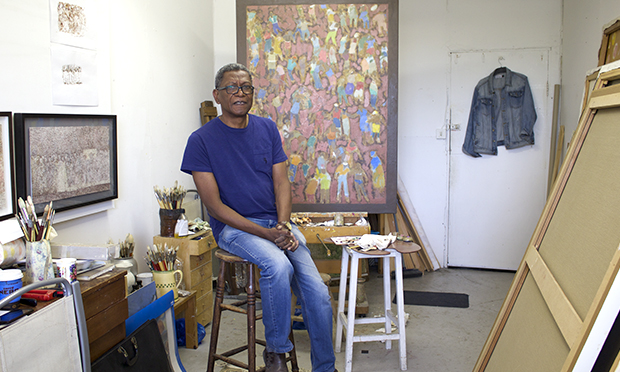Short film on view at Hackney Museum zooms in on the life of painter Paul Dash

Paul in his studio.
Paul Dash began painting as a way of reconnecting with his Caribbean identity.
In 1957 he found himself in unfamiliar surroundings. He was an 11-year-old boy who had just left his home in Barbados to join his family in Oxford.
Filmmaker and journalist Martha McAlpine has documented Dash’s struggles to live as a migrant in post-colonial Britain in a short film now showing at Hackney Museum.
“I was drawn to his story because I think through his art (and through his life) he speaks about the legacies of racism and imperialism in our country and what the impact of that has been for the black British population who migrated here,” McAlpine explains.
When Dash was a boy, his father ran a choir in the front room of their house.
He recalls standing at the doorway whilst the choir brought the sheet music to life. And now when he paints Dash always listens to choral music. “It stuck with me,” he explains in the film.
In his studio on Fish Island, among various finished and unfinished canvasses, Dash in flat-cap and fleece recalls those early days.
“There weren’t that many black people in Oxford,” he remembers.
Growing up in Oxford, Dash felt too nervous to go out and play with other children. He remembers how he would climb to the top of a double-decker bus and gaze out on the people below.
“You sank or you swam,” he says.
His experiences led him to the paint brush, with Dash honing a technique where he would start with spots of paint and work outwards.
“I didn’t paint pictures of Oxford but of Barbados, as a way of recognising that I was Caribbean and had a Caribbean cultural experience,” he says.
From being the only black pupil in his school, Dash went on to study at Chelsea School of Art. But he never made the leap to become a professional artist as he felt that he didn’t fit into the art world.
Instead Dash taught art for 40 years, most recently at Goldsmiths, where he was head of one the MA art courses until his retirement. He has a PhD and has published books and essays on art education, culture and identity.
At five minutes long, the film is a brief yet moving portrayal. McAlpine would like it to be the starting point for a longer film.
“Paul’s art often depicts crowds of people celebrating in some way,” she says.
“Caribbean Carnival ultimately has its roots in resistance to oppression and to this day is still a powerful expression of that.
“I hope to explore and illustrate what this notion of ‘Black Art’ really is and through Paul’s experiences as a migrant in Britain and his artistic expressions of Caribbean carnival, what could be said about the ‘Black British experience.”
People Power, Black British Arts and Activism in Hackney
Hackney Museum,
1 Reading Lane, E8 1GQ
